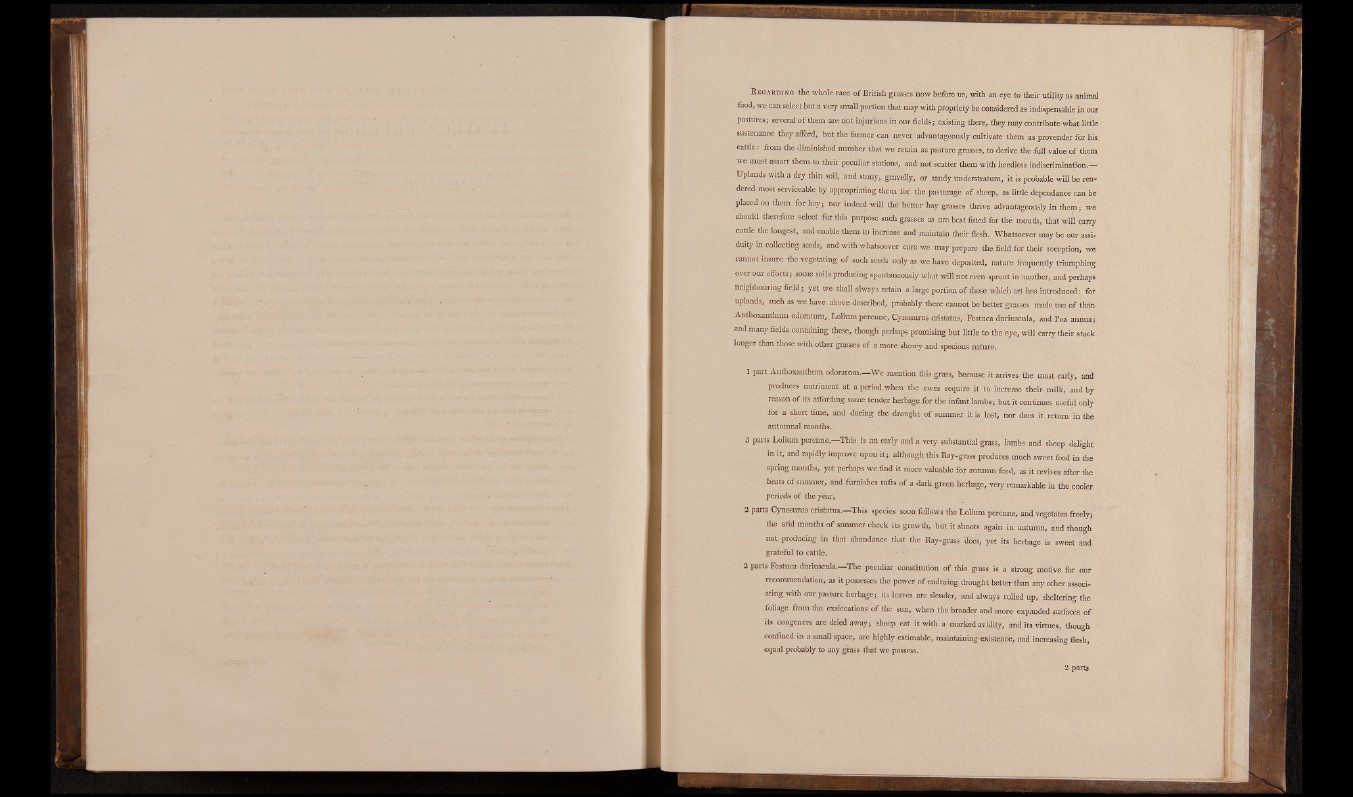
R egarding the whole race of British grasses now before us, with an eye to their utility as animal
food, we can select but a very small portion that may with propriety be considered as indispensable in our
pastures5 several o f them are not injurious in our fields ; existing there, they may contribute what little
sustenance they afford, but the farmer can never advantageously cultivate them as provender for his
cattle: from the diminished number that we retain as pasture grasses, to derive the full value o f them
we must assort them to their peculiar stations, and not scatter them with heedless indiscrimination.—
Uplands with a dry thin soil, and stony, gravelly, or sandy understratum, it is probable will be rendered
most serviceable by appropriating them for the pasturage o f sheep, as little dependance can be
placed on them for hay; nor indeed will thd1 better hay grasses thrive advantageously in them* we
should therefore select for this purpose such grasses as are best fitted for the mouth, that will carry
cattle the longest, and enable them to increase and maintain their flesh. Whatsoever may be our assi-,
duity in collecting seeds, and with whatsoever care we may prepare the field for their reception, we
cannot insure the vegetating of such seeds only as we have deposited, nature frequently triumphing
over our efforts ; some soils producing spontaneously what will not even sprout in another, and perhaps
neighbouring field; yet we shall always retain a large portion o f those which art has introduced: for
uplands, such as we have above described, probably there cannot be better grasses made use o f than
Anthoxanthum odoratum,. Lolium perenne, Cynosurus cristatus, Festuca duriuscula, and Poa annua;
and many fields containing these, though perhaps promising but little to the eye, will carry their stock
longer than those with other grasses of a more showy and specious nature.
1 part Anthoxanthum odoratum.—We mention this grass, because it arrives the most early, and
produces nutriment at a period when the ewes require it to increase their milk, and by
reason of its affording some tender herbage for the infant lambs; but it continues useful only
for a short time, and during the drought of summer it is lost, nor does it return in the
autumnal months.
3 parts Lolium perenne.—This is an early and a very substantial grass, lambs and sheep delight
in it, and rapidly improve upon it; although this Ray-grass produces much sweet food in the
spring months, yet perhaps we find it more valuable for autumn feed, as it revives after the
heats o f summer, and furnishes tufts o f a dark green herbage, very remarkable in the cooler
periods o f the year.
2 parts Cynosurus cristatus. This species soon follows the Lolium perenne, and vegetates freely;
the arid months o f summer check its growth, bat it shoots again in autumn, and though
not. producing in that abundance that the Ray-grass does, yet its herbage is sweet and
grateful to cattle.
2 parts Festuca duriuscula.—The peculiar constitution o f this grass is a strong motive for our
recommendation, as it possesses the power of enduring drought better than any other associating
with our pasture herbage; its leaves are slender, and always rolled up, sheltering the
foliage from the exsiccations of the sun, .when the broader and more expanded surfaces of
its congeners are dried away; sheep eat it with a marked avidity, and its virtues, though
confined in a small space, are highly estimable, maintaining existence, and increasing flesh,
equal probably to any grass that we possess.
2 parts